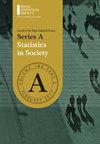冠状病毒大流行期间印度卢比汇率波动分析的结构断裂检测新方法和集成方法
IF 1.6
3区 数学
Q2 SOCIAL SCIENCES, MATHEMATICAL METHODS
Journal of the Royal Statistical Society Series A-Statistics in Society
Pub Date : 2023-06-14
DOI:10.1093/jrsssa/qnad078
引用次数: 0
摘要
在这项工作中,我们开发了一种方法,利用t分布随机邻居嵌入(t-SNE)技术和非参数谱密度估计来检测多变量时间序列数据中的结构断裂。通过将提出的算法应用于印度卢比对四种主要货币的汇率,我们确定冠状病毒大流行(COVID-19)确实导致了波动动态的结构性断裂。接下来,为了研究疫情对印度货币市场的影响,我们提供了一种紧凑而有效的方法,将三个模型结合起来,每个模型都有一个特定的目标,以解释和预测汇率波动。我们发现,前瞻性的制度变化会降低持久性,而COVID-19等外生冲击会使市场具有很强的持久性。我们的分析表明,尽管发现所有汇率都暴露于共同的结构性断裂,但四个系列的影响程度有所不同。最后,我们开发了一种集成方法,在波动率预测的背景下结合多个模型的预测。通过模型置信集过程,我们证明了该方法提高了基准模型的精度。对我们的研究结果提供了相关的经济学解释。本文章由计算机程序翻译,如有差异,请以英文原文为准。
New methods of structural break detection and an ensemble approach to analyse exchange rate volatility of Indian rupee during coronavirus pandemic
In this work, we develop a methodology to detect structural breaks in multivariate time series data using the t-distributed stochastic neighbour embedding (t-SNE) technique and non-parametric spectral density estimates. By applying the proposed algorithm to the exchange rates of Indian rupee against four primary currencies, we establish that the coronavirus pandemic (COVID-19) has indeed caused a structural break in the volatility dynamics. Next, to study the effect of the pandemic on the Indian currency market, we provide a compact and efficient way of combining three models, each with a specific objective, to explain and forecast the exchange rate volatility. We find that a forward-looking regime change makes a drop in persistence, while an exogenous shock like COVID-19 makes the market highly persistent. Our analysis shows that although all exchange rates are found to be exposed to common structural breaks, the degrees of impact vary across the four series. Finally, we develop an ensemble approach to combine predictions from multiple models in the context of volatility forecasting. Using model confidence set procedure, we show that the proposed approach improves the accuracy from benchmark models. Relevant economic explanations to our findings are provided as well.
求助全文
通过发布文献求助,成功后即可免费获取论文全文。
去求助
来源期刊
CiteScore
2.90
自引率
5.00%
发文量
136
审稿时长
>12 weeks
期刊介绍:
Series A (Statistics in Society) publishes high quality papers that demonstrate how statistical thinking, design and analyses play a vital role in all walks of life and benefit society in general. There is no restriction on subject-matter: any interesting, topical and revelatory applications of statistics are welcome. For example, important applications of statistical and related data science methodology in medicine, business and commerce, industry, economics and finance, education and teaching, physical and biomedical sciences, the environment, the law, government and politics, demography, psychology, sociology and sport all fall within the journal''s remit. The journal is therefore aimed at a wide statistical audience and at professional statisticians in particular. Its emphasis is on well-written and clearly reasoned quantitative approaches to problems in the real world rather than the exposition of technical detail. Thus, although the methodological basis of papers must be sound and adequately explained, methodology per se should not be the main focus of a Series A paper. Of particular interest are papers on topical or contentious statistical issues, papers which give reviews or exposés of current statistical concerns and papers which demonstrate how appropriate statistical thinking has contributed to our understanding of important substantive questions. Historical, professional and biographical contributions are also welcome, as are discussions of methods of data collection and of ethical issues, provided that all such papers have substantial statistical relevance.

 求助内容:
求助内容: 应助结果提醒方式:
应助结果提醒方式:


